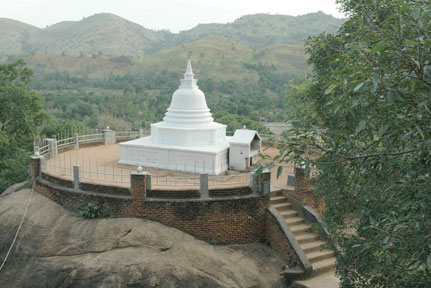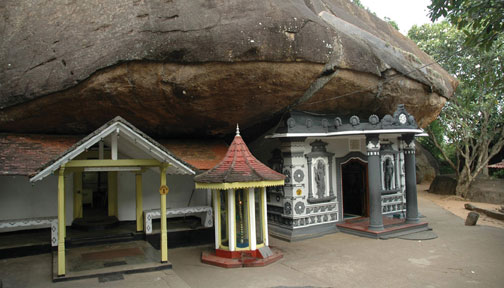|
Sri Sankhapala Raja Maha Vihara:
A Buddhist shrine with dual significance
by Nivanthi THILAKARATNE
|

Stupa
|
Pussadeva, a warrior of king Dutugemunu (161-131 BC) was famous as an
excellent archer. After winning the war against Elara, King Dutugemunu
had given gifts who contributed to the victory. Pallebedda village was
gifted to Pussadeva. However Pussadeva was ordained as a bhikkhu. Later
he achieved the state of Arahantship.
According to folklore Pussadeva resided at Sri Sankapala Vihara at
Pallebedda and had gifted the vihara to the Maha Sangha. The
archaeological remains in the vihara substantiate the claim. A Brahamin
inscrisption can be seen in the cave of the vihara even today.
According to the Brahamin inscription the cave had been gifted to the
Maha Sangha by Pussadeva. Although names of Pussadeva and his father had
been mentioned in the inscription, his father’s name has been erased
with the passage of time.
Another archaeological evidence is the emblem of a conch shell carved
in one of the caves of the vihara. The emblem of the conch shell was
used to identify Pussadeva because he was good at blowing it.
The vihara is known today as ‘Sankapala’ because of the conch shell.
In Sinhala ‘Sanka’ means ‘conch shell’. According to folklore the conch
shell of Pussadeva had been treasured in a rock of the place.
Sri Sankapala Raja Maha Vihara is at Pallebedda in the Ratnapura
district. The vihara can be seen near the 24th milepost at Ratnapura -
Hambantota main road. Sankapala Vihara stands majestically on a rocky
mountain. The ruins of ancient buildings, a stupa, a Bo tree and many
caves are the main features of the vihara.
There are ruins of a small stupa around three quarter mile away from
the vihara. This can be seen when you travel from the vihara towards
Pallebedda along Ratnapura - Hambantota main road. The stupa had been
constructed in a square platform. It is believed that Pussadeva had been
cremated there.
Another significant event related to Sankapala Vihara was the story
of Karatota Dharmarama thera during the Kandyan period, king Rajadhi
Rajasinghe arrested Karatota Dharmarama Thera as the king had suspected
him of having close contact with the Dutch.
When Karatota Dharmarama Thera was in prison he wrote a book in verse
form named Bharasa Kavya Gharbha Chakraya. He presented it to the king
through Aththaragama Rajaguru Bandara. Although the king sent the book
to all scholars in Senkadagala, no one was able to comprehend it. After
that the king ordered Karatota Dharmarama Thera to bring the book to the
(Raja Sabawa) to discuss its contents.
After the king understood the Bharasa verse he was pleased.
|

A view of Sri Sankhapala Raja Maha Vihara
Pix: Samantha Weerasiri |
The king bestowed Karatota Dharmarama Thera Sri Sankapala Raja Maha
Vihara and Pallebedda village in 1786 in appreciation of his literary
work.
The extent of the land exceeded 13,000 acres. Even today the Bharasa
verse can be seen in the vihara. It is also known as Bara Nama Gaba
Saka. In Sinhala Literature it is a rare kind of creation.
The Disa flag, Vatapatha and a golden statue of the Buddha were among
the gifts that were given by the king to Karatota Dharmarama Thera.
The sun and moon had been drawn on the Disa flag. The Vatapatha with
a handle of ivory was covered with a red satin cloth. The standing gold
statue of the Buddha is eight inches in height.
There is another statue of the Buddha made of ivory. An ola-leaf
manuscript, that expressed his gratitude to the king is a significant
item in the vihara. Karatota Dharmarama Thera was also elevated as the
viharadhipathi of Sri Pada and low country Sangha Nayake.
There are 14 caves around the vihara, Kataram had been carved on many
caves to drain off rain water. Three caves among them have been
transformed as shrine rooms. One cave, 78x34ft and 18ft high facing the
West and has been divided into two caves by a wall. A picture of the
stupa had been engraved beneath the kataram.
The cave, situated east of the rock, is 20ft long, 20ft wide and 10ft
in height. In this cave there is a Devala devoted to God Katharagama.
Another cave is close to the tombstone of the Pussadeva. It is known as
Thapas Guhawa |

